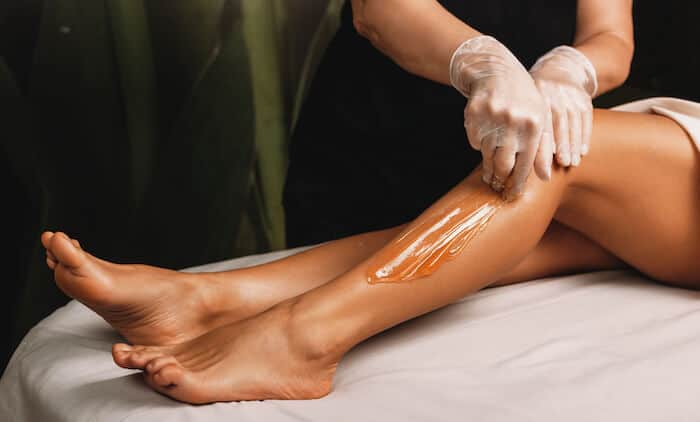You may have heard your friends raving about the benefits of waxing. They claim that the results last a very long time, and they’re perfectly smooth for over a month between appointments. The reason why they get such great results is that they’re consistent with their waxing appointments.
If you’ve waxed once or twice and it seemed like it didn’t work for you, it might not be clear what people are raving about. If you’re considering switching from shaving to waxing, it’s important to understand what to expect when you get started. Here’s how a waxing schedule and proper maintenance can improve your waxing results with each regularly scheduled appointment.
How Does Hair Grow?
Hair grows a lot like a plant. It begins in the follicle below the surface of the skin. The hair shaft, like a stalk of grass, uses a part of the hair follicle called the papilla as its nutrient source. It continues to strengthen and grow until it reaches through the surface of your skin like a sprouted seed emerges from the soil. This first step is called the anagen phase of your hair’s life cycle.
The second step, called the catagen phase, occurs when the hair separates from its nutrient source. It’s no longer actively growing. The hair becomes loose and starts to move further above the surface of the skin.
The final part of the hair growth cycle is the telogen phase. During the telogen phase, the hair is just waiting around for new hair to form and replace it. You’ll naturally shed hair during this period as the new one grows and the old one falls out.
This process is always at work, which is why you probably never notice bald spots on parts of your body where you grow hair. A new hair will pop up right next to where an old hair fell out. Your body hair (as well as the hair on your head) will remain a consistent length and density because it’s constantly being replaced as it sheds.
What Happens After Your First Wax?
During your first wax, you’re going to catch hair at all stages of growth. Hair that’s still attached to the papilla will stay gone the longest. When the hair is ripped from the papilla, the papilla is damaged. This makes it harder for your body to produce new hair in its place and can potentially prevent new hair from growing in the same spot.
Damaging a part of your body may sound scary, but the only purpose of the papilla is to grow hair. If you plan to continue to remove the hair in the area forever, there’s no real harm in allowing the papilla to be damaged or destroyed. The hair that regrows in that area is more likely to be thinner, finer, and lighter because its nutrient source has been compromised. Sometimes, the papilla will stop feeding hair altogether.
You’re also going to grab hair in the other two stages of growth, and these hairs will grow back much sooner. Hair in the telogen phase is already in the process of being replaced by new hairs. Some hairs that have been released from the papilla but haven’t yet emerged from the surface of the skin may show up. This isn’t your hair growing back quickly. It’s hair that already existed but was too short for the wax to grab.
How Often Should I Wax?
The goal is to catch all the hair in the same phase of growth. If you’re able to remove most of the hair while it’s in the same growth phase, it will all return at the same time. This leads to a smooth result without any recurring spots or patches.
How often you should wax depends on the rate of your hair growth and how many times you’ve waxed before. If you’re new to waxing, you may need to schedule your appointments more frequently. If your growth cycle syncs up, you can go longer between appointments.
This can be anywhere between 2 weeks and 6 weeks. Your aesthetician will be able to give you specific advice after assessing your hair type and growth.
What To Do Between Waxes
You should always cleanse, exfoliate, and moisturize between waxes. Cleansing is a given. It’s important to clean your body, and you’re likely already following this step. Exfoliating with a product like a sugar or salt scrub can help to remove dead skin cells that might make it harder for hair to grow through the surface of the skin, causing ingrown hair.
Moisturizing every part of your body is always important, but it’s especially important after you’ve waxed. Your skin will be a little sensitive, and it needs some extra moisture to quench its thirst. Choose a fragrance-free, dye-free lotion to avoid irritation. Look for skin-healthy ingredients like aloe vera or vitamin E.
You may feel tempted to shave between waxing appointments if you notice some regrowth. You shouldn’t. When you shave, you’re cutting the hair bluntly to the surface of the skin. The wax needs something to hold onto, and it can’t grab the hair if it’s too short. You should leave the hair alone between appointments.
If you notice a few stray hairs you’d like to get rid of, it’s best to remove them with a pair of strong tweezers and a strong grip. You should only pluck if you’re sure you’ll be able to remove the hair from the root.
What Happens When You Wax Regularly?
Regular waxing can lead to thinner body hair. Some people notice that some of their hairs never grow back, even if they stop waxing for a long period of time.
Each waxing session is a little easier than the previous session. Your first session might be a little uncomfortable, but over time, your body gets acclimated to the process. It takes less force to remove hairs after the papilla has been damaged. The tugging or ripping sensation feels diminished.
Begin Your Waxing Schedule
If you’re interested in starting a waxing routine, you can book an appointment online or by phone with Greentoes in Tucson. Our estheticians are always here to walk you through the process and answer your questions. We’ll be able to help you establish a waxing schedule that will keep you smooth and soft year-round.

